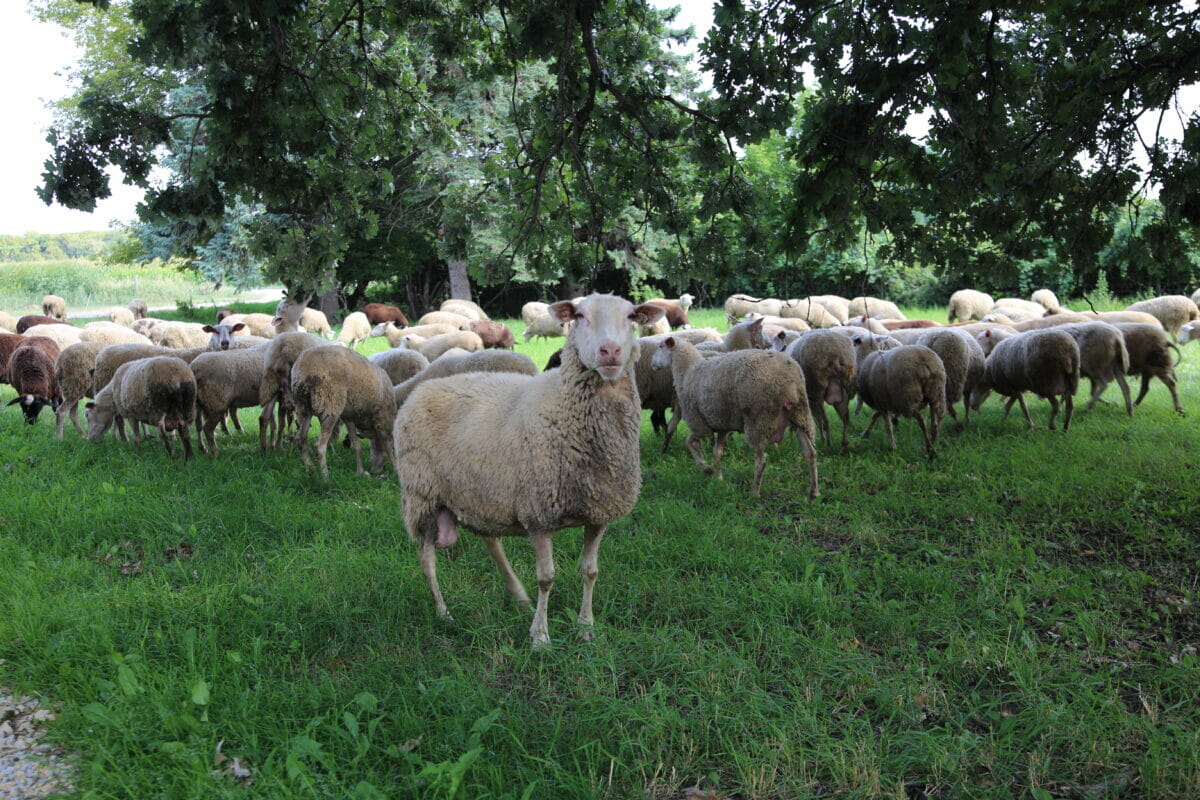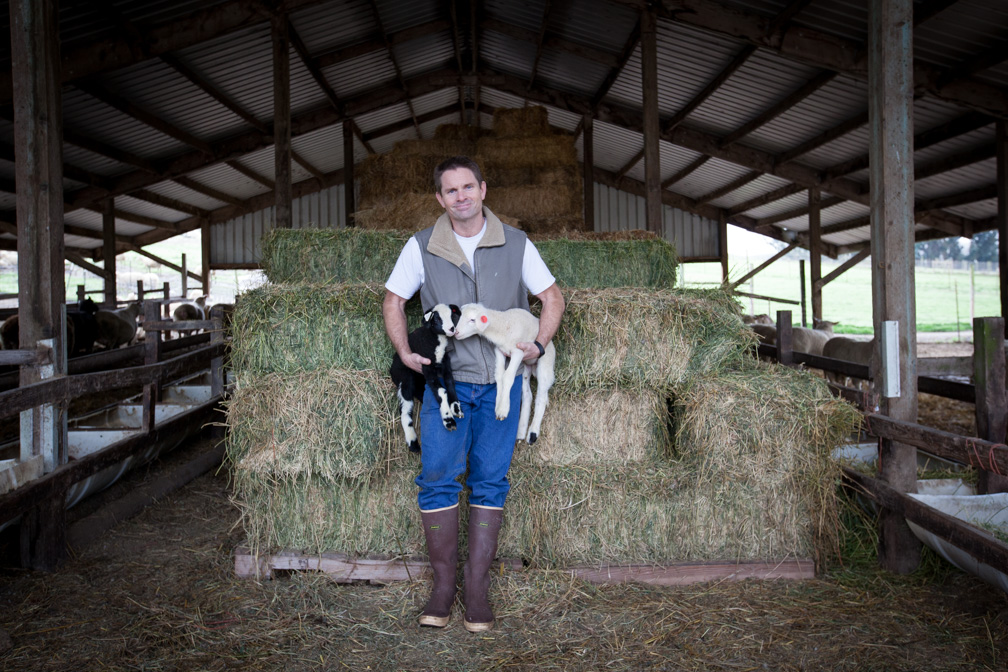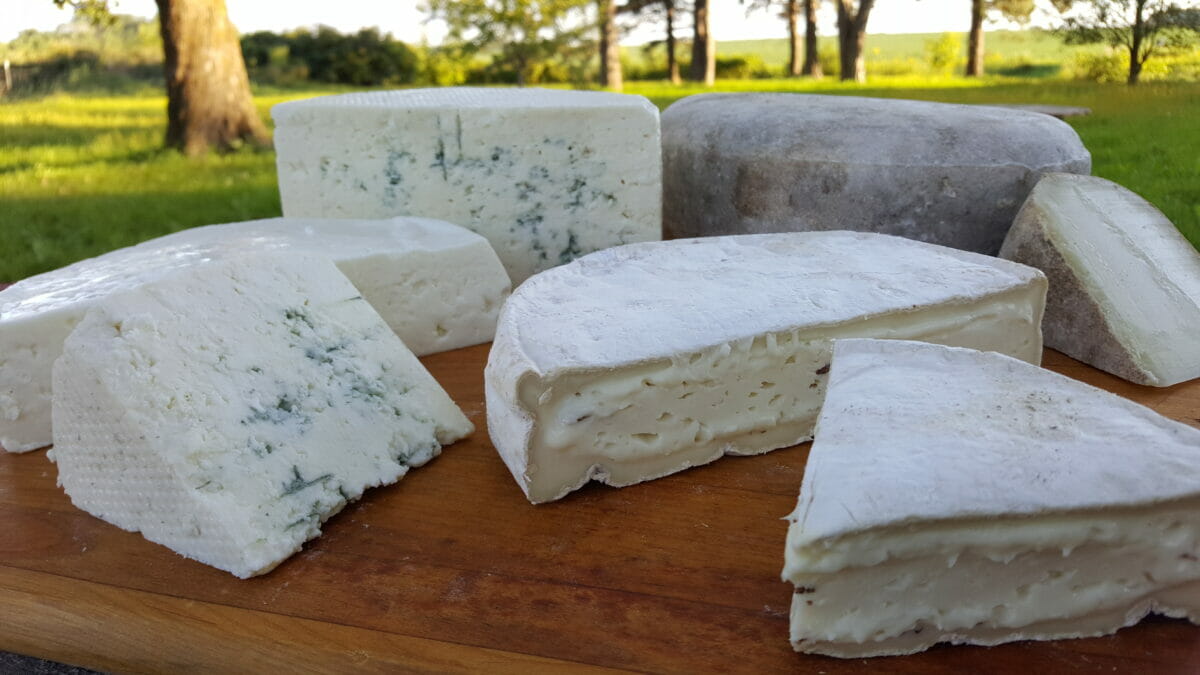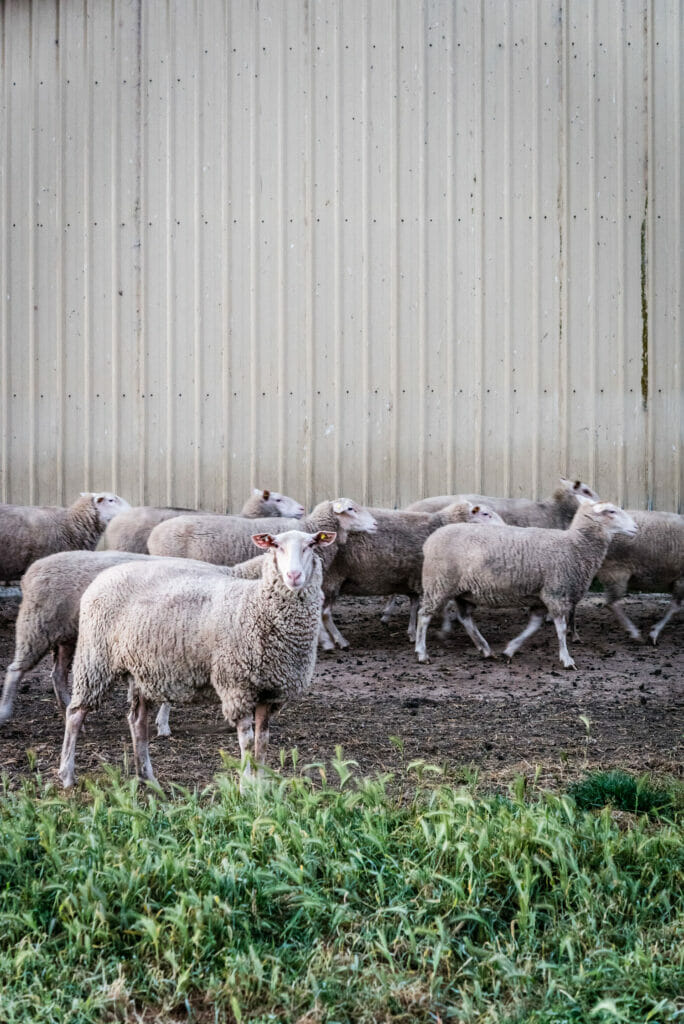There are fewer than 200 sheep dairies in the US. Due to a lack of support for the industry, that number is unlikely to change anytime soon.

The challenges of small-scale farming are well documented, especially in a world grappling with issues caused by the COVID-19 pandemic. Supply chains have been disrupted and consumers now shop for food differently. Climate change continues to take a toll.
“With fire and droughts, the cost of grains and hay is going up and we can’t keep raising the price of our cheese,” says Steven Read, co-owner of Shepherd’s Way Farms in Minnesota.
On top of all that, there are unique challenges involved in sheep dairying, especially in the United States. It’s estimated that there are a little more than 40,000 American dairy farms. Fewer than 200 of those are sheep dairies. Thanks to historically restricted genetics, a lack of infrastructure and the limited milk production inherent to sheep, that number is not likely to grow anytime soon. Even if a farm can figure out its production, genetics and marketing, there’s a serious lack of institutional support for the industry.
“There’s no one in the room saying, ‘What about the dairy sheep?’ I would bet that most of them aren’t aware there’s even such a thing as dairy sheep,” says Read.
He cites aid programs available to farmers that aren’t available to manufacturers and programs for manufacturers that aren’t available to farmers. Farms such as Shepherd’s Way, which raise and milk sheep and then make cheese from said milk, are doubly disqualified.
“If the cow industry wanted to change that rule, it would be changed because it’s a meaningful constituency. That rule would never have been written for the cow industry,” says Read.
“I hate sounding pessimistic, but, in some ways, raising dairy sheep is a losing battle in this country,” says Kendall Russell, owner and cheesemaker at Lark’s Meadow Farms in Rexburg, Idaho. “Compared to a cow or goat’s milk cheesemaker, you’re always behind.”
Why Choose Sheep?

Jodi Ohlsen Read, left, with sheep milk cheese and Steven Read with their sheep. Photos courtesy of Christine Hyatt and Robb Long.
In 1994, Steven Read (a dairy nutritionist) and Jodi Ohlsen Read (a journalist) founded Shepherd’s Way Farms in Nerstrand, Minnesota. They started making their flagship Friesago, a natural rind semi-aged sheep milk cheese, in 1998 and started winning awards for it in 2002.
In 2005, they experienced a devastating fire. Their barn, as well as 500 of their sheep and lambs within it, went up in flames.
“People would call us crying,” says Read. “They had this tremendously personal reaction to it.” The community rallied to support them.
“I don’t mean to make light of this,” he continues, “but there are fires with hogs or cows frequently and people feel bad, of course, but they just have a different reaction to sheep. We seem to have a visceral connection to sheep and shepherding.”
In many ways, sheep can feel like an easy sell for prospective farmers. They require lower capital costs to start. They produce wool as well as milk. It’s easier to stand out in local markets.

Liam Callahan, owner of Bellwether Farms. Photo courtesy of Bellwether Farms.
Liam Callahan, owner of Bellwether Farms in Petaluma, California, finds that many of the farm’s customers have tried plant-based milk products and come to sheep milk in search of something that tastes more like cow milk. “They’re just not happy with the quality of those products, so they come to us,” he says. “Sheep milk tastes a lot like cow milk and gives products that are similar but more digestible.”
Sheep in the United States
Many of the great cheeses of the world are made from sheep milk, from the Pecorino family to Roquefort to Manchego. But the existence of these historic European cheeses doesn’t always translate to American awareness.
“We still get people who don’t know you can milk a sheep,” says Callahan.
Much like with cows, where Holsteins are better for milking and Angus are better for steaks, there are some sheep that are better for dairying, such as East Friesian or Lacaune (the breed responsible for Roquefort milk). However, many of those breeds have only recently become available in the United States.
In the early 2000s, when Mad Cow disease was in the news, there was concern about a potential sheep variant of the fatal disease, explains Russell. There was a block around the import of sheep sperm, eggs or embryos into the US that only was officially lifted in the past five years. Callahan adds that, during that time, there would sometimes be brief windows to bring in genetics from Canada, but those were sporadic. The genetics for Lacaune sheep, considered one of the best-performing breeds of dairy sheep, only came to this country in 2017.
Even today, although not legally restricted, genetics can be difficult to obtain. “Frankly,” says Callahan, “European producers have no incentive to let the goose that lays the golden egg leave Europe.” If American sheep dairies want multi-generational dairy animals, they must breed them themselves.
“Everyone has to start from scratch,” he says.
Sheep Milk vs. Cow Milk

An assortment of Shepherd’s Way sheep milk cheeses.
A cow gives an average of eight gallons of milk a day for the 305 days of her lactation cycle. According to Callahan, with the typical US dairy sheep, “you’d be happy to get maybe three pounds [one-third of a gallon] a day of milk, often less.” Sheep do have more fat and protein in their milk, meaning you can get more cheese per pound of milk, but that doesn’t make up for the lack of volume.
Stronger dairy sheep breeds can yield four to six pounds a day, and six months of lactation is seen as pretty good in the United States. Many European sheep breeds can milk for 10 months, which Bellwether has sometimes been able to do.
Those longer lactation periods, Callahan notes, essentially involve the same amount of work and only a little more feed, compared to an animal who’s not lactating. More milk per cycle is a “game changer,” he says, especially where pregnancy and giving birth entail a health risk for the animals.
“Even though you have some lower costs,” says Read, “because sheep won’t eat as much as a cow, the fact they’re producing so little is really challenging.”
Ohlsen Read continues, “We get much less milk per animal than cow or goat, but we don’t get more per pound for cheese in general. I think people may value sheep cheese more, but it doesn’t necessarily bring more value.” Along with making cheese and caring for their animals, there’s a tremendous amount of education to be done, on top of basic marketing tasks such as maintaining a website and/or social media accounts.
“Do other people want to work this hard for this little?” says Read. “I don’t know.”
Small Scale by Design
In 2019, Agriculture Secretary Sonny Perdue under Donald Trump told farmers in Wisconsin: “In America, the big get bigger and the small go out.” If that’s the case, nearly every sheep dairy in America is in trouble.
The reality is that sheep just don’t make as much milk as cows or goats, and there are no mega-sheep dairies in this country. “Sheep cheese production is inherently going to be smaller-batch,” says Ohlsen Read. “Every single input for us costs more.” She gives the example of paper towels. If she buys paper towels, she’s buying a case. If a larger production facility buys paper towels, they buy a semi-load. “Every single input is a lower price for them.”
Callahan notes the American emphasis of large-scale producers in general. This, he says, is not entirely a bad thing.
“We need people who can make a lot of food. We have a lot of people and we feed a lot of people outside the country,” he says. “But I think it’s pretty clear that small-scale production adds a richness to the community.”
Sheep farming also offers small farmers an opportunity to practice regenerative agriculture at a manageable scale, an important motivator for Shepherd’s Way in Minnesota. “Our sheep are on pasture,” says Ohlsen Read. “When they’re on pasture, they fertilize it and they help sustain a system that sequesters carbon. This leads to healthier soil and a cleaner water system.”
The Future for Sheep Dairies

Photo courtesy of Bellwether Farms.
Callahan is cautiously optimistic about the industry. He says the American sheep dairy industry is about 20 years behind our goat dairy industry, which grew in the past 20 years from people not knowing that you could milk a goat to goat cheese being a salad staple.
“We’ve been approached by several European companies wanting to partner on things,” he says. “The US is the most important market for them now, as we’re one of the few dairy markets at retail that’s still growing at a decent rate. Europe’s been flat for some time.”
Will this be an uphill battle? Almost certainly. There are programs in Europe to support sheep dairying, says Callahan, “because it’s so fundamental to what they are about there. It’s their pride, their identity and what the communities historically have done.” He recalls visiting a sheep dairy in Tuscany, which was building a new milking parlor with money from a government grant. (Government aid programs for dairy sheep do not exist in this country. Read cites the North American Dairy Sheep Association’s work to try to change that.)
It’s also a quickly-evolving market. Callahan explains that, decades ago, Bellwether got its start in the local farmers’ market scene. Today, though, each town has its own farmers’ market, so the foot traffic is more spread out. They don’t get the same returns at individual farmers’ markets that they once did.
Ohlsen Read says that the distribution market is continually shifting, especially post-COVID. There are regional distribution channels as well as national ones. Wholesale business dried up when COVID hit, and figuring out new channels has been a constant challenge. Shepherd’s Way is currently testing out bottled milk to sell at retail and wholesale, hopefully to local coffee shops.
“Those guys can afford it,” says Read. “Their cost is so low, hopefully, they’ll pay a little more to offer sheep milk with their espresso.”
The Last of the First
Since Shepherd’s Way began in 1994, it has seen dozens of its farming peers leave the industry. “There is a continual turnover in a way that I have not seen in other industries,” says Read. “We’re one of the last of the first.”
Ultimately, the people who do this do it because they like it. They like sheep. They like feeding their communities. They feel a sense of purpose. Ohlsen Read notes the satisfaction whenever she hears that the cheese she made is on a new restaurant menu or was served at a wedding. “The rewards are profound,” she says. “There’s a whole big circle connecting from when the sheep are out on pasture to when the cheese is on someone’s plate. I loved raising my family this way.”
“It’s a cool gig if you can get it,” says Read. “There’s just no money in it.”
You have numerous of the historic facts incorrect. Some of the most prominent players/producers were left unmentioned such as the Majors in the NE and the Tenn. producers and some of the West coast producers. This article lacks true history and only touches a few producers. What about all of the extensive work that the Univ. Wisc. did with the only Dairy sheep research facility in the U.S. ? Cornell faculty and alum’s played a large role in getting the industry established and supported it for many years ( the Clarks ). The late Dr. Thonney from Cornell. Yves Berger… Read more »
Well done Ms Clark for putting together a broad but reasonable overview of the state of the dairy sheep industry in the US. I am one of the early-but-still–chugging producers, and like my cohorts Liam Callahan and Steven Read, I have watched the revolving door of new dairy sheep farmers for the past 25 years. We have been hampered by lack of consumer awareness and, until recently, by very limited access to improved dairy sheep genetics from Europe. UW’s Spooner Station was integral to our developing understanding of milking sheep for many years. When their doors were closed in 2016,… Read more »
I’ve been getting whole milk from the Amish directly from the cow. I also get goat milk directly from the cow. And goats milk is superior to cow’s milk. Now since the sheep are giving milk just last week or two, now I am getting that sheep milk (which is superior to goat milk and twice the period to cow milk); and I have to tell you, when I came home that morning and opened up the half gallon Ball jar that they put it in for me to take home and then I go back for more when I’m… Read more »
I wish my stores sold sheep milk. If rather but that. Specifically because sheep milk contains more fat rather than cows milk. If there was grass-fed, non-homogenized milk, I’d be buying it every other week just to make my creams and butter.
This article raises important questions about the future of sheep dairying in America. While the challenges are significant, it’s also clear that there is a growing interest in sheep milk and its products. With increased consumer demand and support, perhaps this vital sector of the agricultural industry can overcome its hurdles and find a sustainable future.